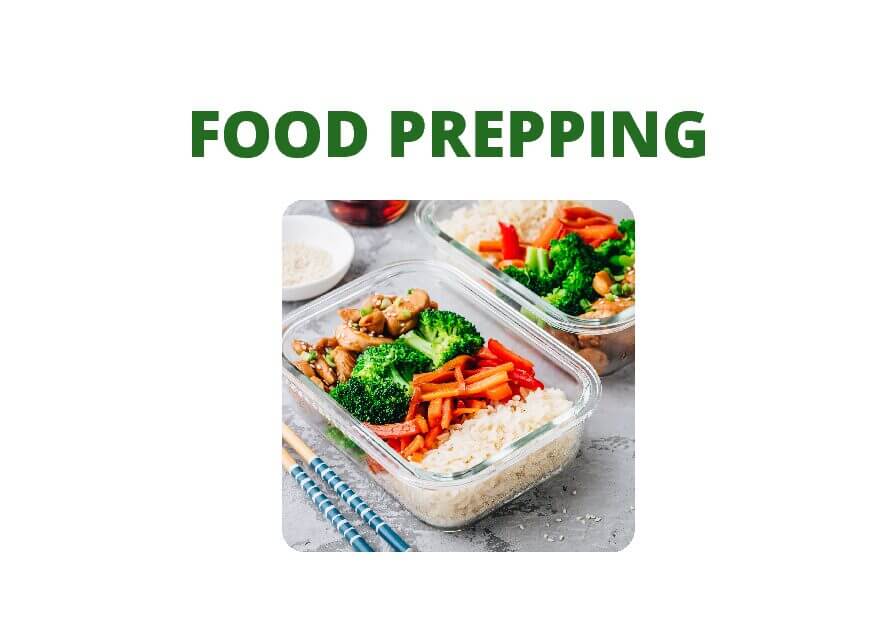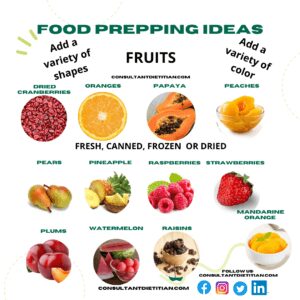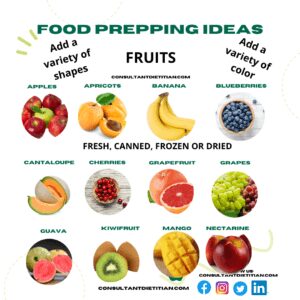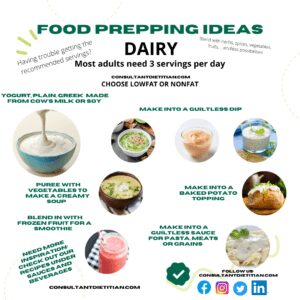Food Prepping
Food Prepping
Food Prepping
Food Prepping can be a great way to eat healthy and watch portions, but do you eat the same foods over and over again? This may not be as healthy as you might think. Getting more variety in your meals gives you more opportunity to get more variety in the nutrients your body needs. Eating the same foods over and over can lead to nutrient overload. For example, tuna is a healthy food option but eating it over and over again can be detrimental to your health. Tuna has a concentrated amount of selenium. Eating tuna over and over can have a negative impact on your health. Broccoli has a high amount of oxalates. Consuming high amounts of oxalates can cause your bones to leach calcium and can even lead to kidney stones in people who are suspectable.
USE THE MYPLATE.GOV AS YOUR GUIDE

As you are planning your meals, consider the myplate.gov guidelines. In the myplate.gov guidelines foods are grouped into food groups based on their nutritional contents. The five good groups include fruits, vegetables, proteins, grains and dairy. When meal prepping try to select one from each group for each meal.
Fruits: Fruits can be fresh, frozen, canned or dried. Choose canned fruits that are packed in juice or rinse off the syrup. Be careful with some fruits if you are food prepping for the week as they may become brown over time. Add lemon juice to fruits that brown can help prevent browning.
Vegetables: Vegetables can be fresh, frozen, or canned . Choose a variety of colors, from dark green vegetables to red orange vegetables. As a rule of thumb, the more variety the color the more variety of nutrients.
Proteins:Meats, poultry, seafood, eggs, nuts, seeds, beans, peas and lentils and soy products are in the protein group. Select a wide variety of protein foods to get more of the nutrients your body needs and for health benefits. Choose meat and poultry that are lean or low fat. Choose seafood that are higher in fatty acids (omega 3s) and lower in methylmercury such. Try some meatless meals that include beans, peas and lentils, nuts, seeds and soy products. (Beans, peas, lentils are also part of the vegetable group)
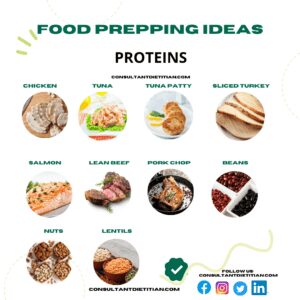
Grains: Any food made from wheat, rice, oats, cornmeal, barley any other cereal grain is a grain product. Breads, pasta, breakfast cereal, grits and tortillas are examples of grain products. Grains are divided into 2 subgroups: Whole grains and refined grains. Whole grains contain the entire grain. Refined grains have been milled. Choose refined grains that have been enrich.
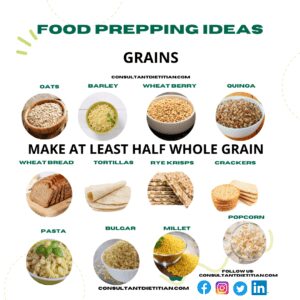
Dairy: The dairy group includes milk, yogurt, cheese, lactose free milk, and foymilk and yogurt. Do not forget the dairy. Dairy provides health benefits especially for building and maintaining strong bones. Please note that other “milk” such as almond, rice, coconut, oat and hemp are not nutritionally equivalent to dairy and are not included in the dairy group.
ADD SOME HEALTHY FATS AND FIBER
Add some healthy fats to your meal prepping. Adding healthy fats can lower your blood sugar and provide satiety. Healthy fats will aid in digestion and will make you feel more satisfied. Do not forget about high fiber foods. High fiber foods help to regulate blood sugars and aids in digestion. Fiber can lower cholesterol and remove harmful fats from the blood stream.
ADD SOME HERBS AND SPICES
Add seasoning and sauces to meals. Add herbs and spices in the diet has many benefits. The antioxidant properties of herbs and spices can lower the oxidative modifications of low density lipoproteins cholesterol in the development of atherosclerosis. Consuming herbs and spices can may health benefits. Garlic can lead to lower cholesterol, lower blood pressure and possibly have cancer fighting properties. Turmeric is beneficial for anti-inflammatory and antioxidant effects. Spices and herbs such as clove, rosemary, sage, oregano, cinnamon, ginger, black pepper are excellent sources of antioxidants.
How much should you add to your food plan?
The MyPlate Plan Shows your food group targets -what and how much to eat within your calorie allowance.
Your food plan is personalized, based on your:
Age
Sex
Height
Weight
Physical activity Level
MY PLATE PLAN FOR YOU
SAMPLE RESULTS :
Putting together a plan.
Now that you have your personal my plate plans the servings into divide into three or four meals per day. You can chose what fits into your schedule and preferences. It is recommended however to eat throughout the day to give your body fuel and not just eat one large meal per day.
For Example:
2 cups :Fruits you may wish to have = 1 cup at breakfast and ½ cup at lunch and dinner
2 ½ cup Vegetables :you may wish to have 1 cup at lunch and 1 ½ cup at dinner
6 ounces of grains: you may wish to have 2 oz. at each meal
5 ½ ounces of proteins: you may wish to have 1 oz. at breakfast, 1 ½ oz. at lunch and 3 oz. at dinner
3 cups
Tips:
- Make the sides the stars of the plate.
- Add sauces and low fat dressing to make the meal tasty. You can purchase sauce or make them on your own. Look for simple recipe ideas in our sauce section of the recipes.
- Choose a variety of fresh, frozen, dried and canned (no salt variety). If you are prepping or planning for 5 days choose a variety of fruits and vegetables. Choose 2-3 different servings of fruits and 2-3 different servings of vegetables per day. For example, 3 fruits per day, for 5 days may mean 15 different fruit servings. (3 apples, 3 bananas, 2 oranges, 2 cups frozen mangos, 1 cup frozen pineapple, ¼ cup dried cranberries). Choose what you like but get variety.
- Chose fruits and vegetables that are in season.
- Keep frozen fruits and vegetables on hand. They are easy to prepare and add.
- Chose a variety of shapes, colors and textures. Colors make the meal visually appealing. Fruits and Vegetables will give color to your meal.
- Purchase Lean Meats in Single Servings from Butcher counter if cooking for one.
- Purchase Lean Meats in smaller packages, prepare and freeze for up to 30 days in the freezer.
- For grains make a few servings and store in the freezer in individual containers to use later and save time. Store for up to 30 days in the freezer for best quality.
- For grains add some sauces or seasonings to make them more interesting.
- Stock up on your favorite dried herbs and spices to add for flavor.
- Pre-cooked chicken or low sodium sliced turkey from the deli can save time. Watch the sodium content to be sure it is not high in sodium. (<140 mg. sodium per serving)
Sample Meal Plans:
Salmon and Tofu Stir Fry with Garlic, Brown Rice, Carrots Seasoned with Turmeric, Mixed Greens with Dried Cranberries in a Balsamic Vinegar Dressing.
Chicken, Barley Salad, Brussels Sprouts with Sweet and Spicy Sauce, Spinach Salad with Orange Sections and Low fat Feta Cheese.
Tuna Salad served on Leafy Greens, Whole Grain Crackers, Red Pepper Rings, Cucumber Slices, Mango Chunks, String Cheese
Pork Loin Chop with Honey Mustard Sauce, Couscous, Bok Choy Sauté with Garlic, Yogurt Parfait with Mixed Berries

